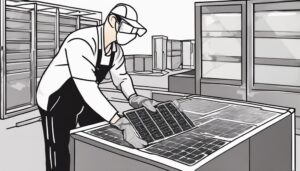Did you know that, depending on their location and angle, solar panels can lose between 10-25% of their potential energy output? It’s a significant figure that you can’t afford to overlook when you’re investing in solar energy.
To harness the sun’s power more efficiently, you’ve got to pinpoint the optimal angle for your solar panels, which varies based on your geographical position and the time of year. But it’s not just about slapping a solar panel onto a roof and calling it a day. You must consider the tilt and orientation, factoring in seasonal changes that influence solar irradiance.
As you set out to maximize your solar investment, you’ll discover there’s a sweet spot—a particular angle where your panels soak up the most sun, translating into more kilowatt-hours for your buck.
Stick with us as we guide you through the necessary calculations and adjustments to ensure your solar array performs at its peak, regardless of the season.
Listen To The Summary
Determine Your Latitude
To optimize the angle of your solar panels, you’ll first need to pinpoint your exact latitude on the globe. Understanding your position is key because it directly influences how the sun’s rays hit your panels. The solar declination – the angle between the sun’s rays and the equatorial plane – varies throughout the year, and your latitude will guide you in adjusting the tilt of your panels to match these changes.
Latitude’s importance can’t be overstated when it comes to harnessing solar energy efficiently. If you’re closer to the equator, the sun’s path remains more consistent year-round, meaning less adjustment is needed. However, as you move towards the poles, the sun’s trajectory changes more dramatically with the seasons, requiring more frequent modifications to the panel angle.
You’re after the freedom to generate your power, and that’s precisely what understanding your latitude grants you. It’s the roadmap to maximizing the sun’s potential. So, grab a map or use an online tool, find your latitude, and you’ve taken the first crucial step towards energy independence.
Consider Seasonal Adjustments
As the seasons change, you’ll need to adjust the tilt of your solar panels to capture the optimal amount of sunlight. This isn’t just about chasing the sun; it’s about ensuring your freedom from high energy bills and maximizing your return on investment. Panel orientation plays a pivotal role in this seasonal dance with the sun.
In summer, when the sun is high in the sky, a lower angle is often best, reducing the direct impact of the sun’s rays on the panels and preventing overheating. Come winter, the sun hangs lower, and a steeper tilt angle helps catch those scarce rays. Remember, the angle you set in June won’t be as effective in December.
The shading impact is another factor you can’t ignore. As the seasons shift, so do the patterns of shade around your property. Trees that were bare in winter may cast a shadow over your panels in summer. You’ll want to adjust the tilt to sidestep these obstructions or trim foliage to maintain clear access to sunlight.
Calculate the Tilt Angle
Understanding the seasonal nuances in solar panel positioning, you’ll now need a method to precisely calculate the optimal tilt angle for your setup. The angle importance can’t be overstated; it’s critical for harnessing maximum solar power. Here’s how you can align with the sun’s path for energy freedom.
Firstly, take your latitude. This number is a great starting point. For winter, add 15 degrees to your latitude to capture the low-hanging sun. In summer, subtract 15 degrees from your latitude, which helps the panels catch rays when the sun is high. During spring and fall, the tilt angle should roughly equal your latitude. This simple adjustment maximizes exposure during different seasons.
But don’t stop there. Observe the sun’s path through the day. Are there obstructions like trees or buildings casting shadows? Adjust the angle slightly to clear these if possible. Remember, the sun’s position changes, so a one-time calculation isn’t enough. Check and tweak the angle periodically to ensure your panels are always catching the optimal amount of sunlight.
Adjust the Mounting Structure
Once you’ve determined the ideal tilt angle for your solar panels, it’s crucial to adjust the mounting structure accordingly to achieve peak energy production. This isn’t just about nudging the panels a bit; it’s about ensuring that the mounting materials and structural integrity are up to par. After all, your freedom to harvest the sun’s energy hinges on a setup that’s both resilient and flexible.
To start, you’ll need to assess the current mounting system. Is it capable of being adjusted? If not, you might need to invest in a mount that allows for tilting. Look for high-quality, durable mounting materials that can withstand the elements, particularly if you live in an area with extreme weather.
Next, secure the panels at the new angle, making sure every bolt and bracket is tight to maintain structural integrity. It’s essential that the structure is stable and can support the panels for years to come. Remember, your energy independence relies on this solidity.

Adjusting the mounting structure might require some effort, but it’s a small price to pay for the autonomy that comes with optimized solar power. With the right angle and a robust setup, you’re all set to enjoy the full potential of your solar investment.
Secure Panels Correctly
Ensuring your solar panels are securely fastened is critical for both safety and long-term performance. Think of your solar setup as a symbol of independence, harnessing the sun’s power for your use. But without proper installation safety, you’re risking it all.
Loose panels can become dangerous projectiles during harsh weather, and a poor fastening job might lead to costly repairs or replacements down the line.
To safeguard your investment, you’ll want to focus on panel durability. This starts with choosing the right mounting hardware for your specific environment. If you’re in a high wind zone, for instance, make sure the mounting system is rated for those conditions. Don’t just rely on the hardware; inspect the racking system and all connection points regularly. After all, freedom comes with responsibility, and this is no different.
Make sure to follow the manufacturer’s guidelines in the letter. Over-tightening can cause damage just as surely as under-tightening can. You’re aiming for a secure, snug fit that holds the panels firmly in place without warping the frame.
Monitor and Maintain Efficiency
Regularly monitoring your solar panels’ efficiency ensures you’re getting the most out of your renewable energy investment. By keeping a close eye on how your panels perform, you can make adjustments that cater to freedom, freedom from high energy bills and dependence on non-renewable sources.
To maintain peak performance, consider these critical steps:
- Panel Cleaning: Dust, leaves, and other debris can significantly reduce your solar panels’ effectiveness. Clean them periodically to ensure they’re absorbing as much sunlight as possible.
- Performance Tracking: Use monitoring systems to track your panels’ output. This data helps you identify when they’re underperforming and may need attention or repositioning.
- Seasonal Adjustments: As the seasons change, so does the sun’s path. Adjust the angle of your panels to match the solar trajectory for optimal energy capture.
- Inspections for Damage: Check for any physical damage to your panels from weather or wear and tear. Prompt repairs can prevent long-term efficiency losses.
Educating yourself on these maintenance strategies will empower you to take control of your energy destiny. Performance tracking and regular panel cleaning aren’t just chores; they’re your tools for energy independence.
Stay proactive, and watch your solar investment continue to pay off.
Frequently Asked Questions
How Does Shading From Nearby Objects Affect the Optimal Angle for Solar Panels?
Shading from nearby objects significantly impacts your solar efficiency. You’ll want to perform an obstruction analysis, especially considering seasonal shading, to ensure maximum energy freedom all year round.
Can the Color or Material of the Surface Where the Solar Panels Are Mounted Influence the Efficiency of the Angle?
Reflective surfaces can increase efficiency by bouncing light back while mounting stability ensures your panels stay at the proper angle. You’ll harness more energy, granting you greater freedom from conventional power sources.
What Are the Implications of Local Weather Patterns, Such as Frequent Snow or High Winds, on the Positioning of Solar Panels?
You’ll need to consider seasonal adjustments to tackle weather changes; ensuring your panels’ angle durability against snow or winds can maximize energy harvest while upholding your autonomy in power generation.
How Does the Angle of Solar Panels Affect the Accumulation of Dirt and Debris, and What Are the Best Practices for Cleaning?
To reduce dirt buildup, adjust your panel tilt. A steeper angle helps shed debris, lessening cleaning frequency, and granting you more energy independence with less maintenance hassle. Stay proactive for optimal performance!
Are There Any Regulations or Permits Required for Adjusting the Angle of Solar Panels on Residential or Commercial Buildings?
You’ll need to check local zoning laws and obtain proper permits before adjusting solar panel angles to ensure compliance and roof safety. It’s crucial to maintain your freedom to optimize energy efficiency responsibly.
Conclusion
Now that you’ve dialled in your solar panel angle, you’re all set to soak up maximum sunshine! Remember, the right tilt ensures peak performance—so check and tweak it as seasons change.
Keep an eye on your setup for any needed tweaks and always stay on top of maintenance. By staying vigilant, you’ll keep your energy harvest high and your power bills low.



